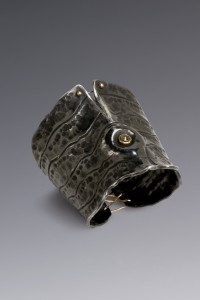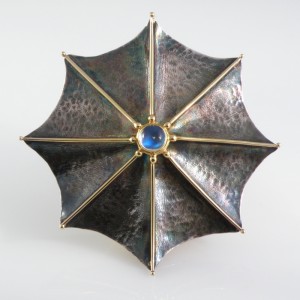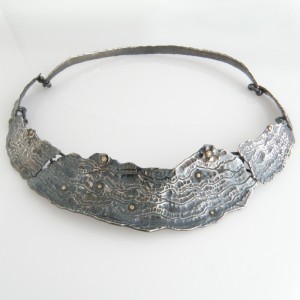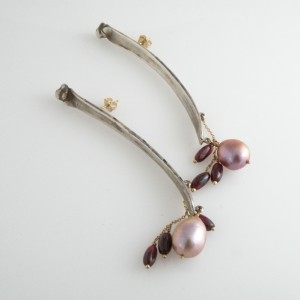By Marcy Clark

When discovering the work of J. Rudy Lewis it does not come as a surprise that he came from a background of Anthropology and Art History, or that his parentage includes notable explorers, a famous ornithologist and art connoiseurs. His pieces have the depth and soul of Byzantine artifacts or Victorian Heirlooms.
I found the experience of learning more about J.Rudy’s life is a bit like curling up with a good book. His fascinating background and his passion for his current projects would make him a wonderful case for a TALENT Q&A.
The Women’s Mafia is working with J.Rudy and planning some upcoming events where you can meet the mysterious and dynamic designer! Will you join us?
Women’s Mafia: How did you get started in the design industry?
J.Rudy: This is hard to answer. In most ways I find it surprising that I am in the industry. I have always made work in different media: photography first, then handmade books, then mosaics and finally jewelry. The jewelry I have made for the last 10 years has been almost entirely one of a kind, specific to an individual’s desires. Truly custom, almost entirely forged. Designing to answer a unique question put before you is a great way to learn design. The more unique the question posed the more interested I am in it.
 I know I’ll never give up doing custom one-on-one pieces but I want to have that process become more selective as I go deeper into answering my own personal design questions. In the last 10 months I have been posing and answering these questions, which I’m finding incredibly exciting. I consider this to be the design industry for me, and what I see for my future.
I know I’ll never give up doing custom one-on-one pieces but I want to have that process become more selective as I go deeper into answering my own personal design questions. In the last 10 months I have been posing and answering these questions, which I’m finding incredibly exciting. I consider this to be the design industry for me, and what I see for my future.
WM: How did you know you wanted to work in jewelry? Have you had any other odd jobs?
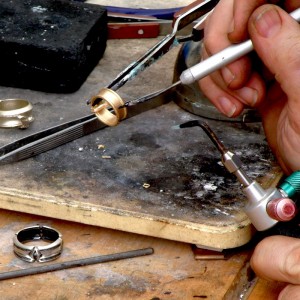
J.R.L.: I did not always know I wanted to work in jewelry. What I know is that I love to design and make work. Making work that shapes to the body, that comes alive as someone wears it, I find more exciting than any other form of art at the moment. I ‘ve recently added aged leather to my metal work and I love how it accentuates the age, history and story I am bringing into my work, now.
As for odd jobs, I shingled houses for awhile in Maine. I worked making mosaics for a while; tables, floors, backsplashes. I worked at a high-end gallery in Philadelphia, The Locks Gallery, for 3 years as preparator. We showed artists like Jennifer Bartlett, Lynda Benglis, Miro, Motherwell, Tom Chimes, Louise Nevelson.
I did several ADAA shows at the 67th street armory. Stressful but fun. I moved art with Gannotta Fine Arts for a few years. Whatever I was doing I was always making things. Then started working for Caleb Meyer and learned how to make Jewelry.
WM: Where do you get your jewelry inspiration?
 J.R.L.: I have been a student of art my entire life. I grew up around it. From this knowledge has come my interest in all arts especially more “tribal” or ancient ones: Masai, Aztec, Mayan, Tlingit, Maori, Aboriginal, etc…
J.R.L.: I have been a student of art my entire life. I grew up around it. From this knowledge has come my interest in all arts especially more “tribal” or ancient ones: Masai, Aztec, Mayan, Tlingit, Maori, Aboriginal, etc…
Then there’s the natural world. I love to think how nature continually repeats itself.
WM: How long have you been a professional jeweler?
J.R.L.: 10 years, but I’ve making art since childhood.
WM: Can you tell me a bit about your family and also how you grew up? How does your family inspire your life?
J.R.L.: My family history is interesting and a great knowledge base to draw from.
I grew up on the main line of Philadelphia. Father a Lawyer; Mother, a Mother. Both very well educated and very involved in the arts and institutions of Philadelphia. My maternal Grandfather, a Baron, was an ornithologist and he and my grandmother, went on fantastic expeditions in the 30’s to Africa and Asia. He wrote several definitive books on birds. My Grandmother was the first white woman to cross the Kalahari desert. He collected specimens for the Academy of Natural Sciences in Philadelphia. He also collected in Brazil as well and has an anaconda named after him.
My father comes from a long line of Philadelphia Lawyers. His eldest ancestor, named Ludwig, originally arrived here as a Hessian soldier, who my father describes as being “shot in the ass running away from General Washington and then marrying his nurse” and going on to start and import business for Chinese ceramics.
As for myself I went to Cornell and got a BA in Anthropolgy and Archaeology and a minor in Photography. I go to museums all the time. I’ve rowed internationally as part of US teams. I coached rowing at Williams College and worked at the Museum there. I’ve taken many courses in bookbinding and photography while working many jobs before arriving at my career in jewelry.
It’s an oddball family history. Not oriented towards the physical making of art, but a great history to pull from. Can’t really say I fully recommend it, but I do have a different view of the world. I feel most like an outsider when it comes to the “design industry.”
WM: You have a number of Victorian inspired pieces. How did you get familiar with this era and how are you re-inventing these classical lines for your designs?
J.R.L.: Comes with the blood. In terms of reinvention I am attaching a description I just wrote for the Victoria’s cuff:
“Drawn from images of 19th century women’s shoes and corseting, this cuff creates a wrapping ritual to allow for the ownership of women’s past restrictive clothing.
Materials: Hand Hammered sterling; carved, cast and riveted sterling vulture heads; hand aged, dyed and finished leather.”
WM: Many of your pieces are very balanced and symmetrical. Is this a part of your personality? How would you describe your design personality?
J.R.L.: Most of that work draws from the symmetry I see in nature, and also my personality. I like to think about the repetition of patterns in nature like a Mandelbrot set.
None of the symmetrical work is absolutely perfect, like any face or body.
I like to work alone. In fact I have barely left my house for the last 10 months as I have been redefining myself.
Every piece I work on seems to lead to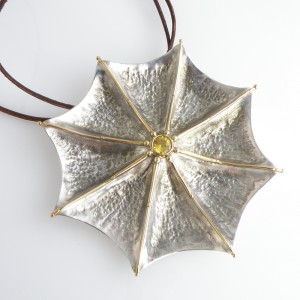 five or six other pieces. I tend to work on up to 6 new designs at a time with many 1/2 started pieces. I design by sitting at my bench and playing. Meaningful play, of course, it’s only easy if you let it be. I might have a question in mind to start with; I might pick up a part left over from another piece. I like to surround myself with a variety of images and I am always googling something as questions arise or I try to clarify an image of some cultural artifact I can’t quite picture. The pieces tend to become layered because of my starting from a past piece and then adding a new image or thought or material until it drifts into another culture or art form. I work until I feel an object reminds me of many ideas so there is enough room for everyone to bring something to it. The pieces I feel are going to become reproducible I then further draw out to fit into a more production ready mode.
five or six other pieces. I tend to work on up to 6 new designs at a time with many 1/2 started pieces. I design by sitting at my bench and playing. Meaningful play, of course, it’s only easy if you let it be. I might have a question in mind to start with; I might pick up a part left over from another piece. I like to surround myself with a variety of images and I am always googling something as questions arise or I try to clarify an image of some cultural artifact I can’t quite picture. The pieces tend to become layered because of my starting from a past piece and then adding a new image or thought or material until it drifts into another culture or art form. I work until I feel an object reminds me of many ideas so there is enough room for everyone to bring something to it. The pieces I feel are going to become reproducible I then further draw out to fit into a more production ready mode.
WM: What metalsmithing techniques do you use in creating your work? How did you learn?
J.R.L.: Apprenticed with Caleb Meyer, who learned from his father James Meyer.
I use basic forging and chasing techniques, lost wax casting and wax carving. I am adding techniques as I go, but only as they fit within my aesthetic. I enjoy keeping the techniques simple and pushing the ideas like limiting myself to 12 bar blues.
WM: What materials do you use in creating your work?
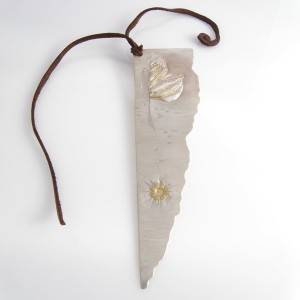 J.R.L: At the moment: Sterling silver; 14k, 18k, 22k gold in different colors; hand dyed and aged leathers, rough diamonds, baroque pearls, chalcedony, blue moonstone, sleepy aquamarine cabochons, imperial topaz, grossular garnet, dinosaur bones and opal. Any material with life in it, a story to tell. If I look at a material and it doesn’t give me something better than “I’m shiny, use me” back, I don’t want it.
J.R.L: At the moment: Sterling silver; 14k, 18k, 22k gold in different colors; hand dyed and aged leathers, rough diamonds, baroque pearls, chalcedony, blue moonstone, sleepy aquamarine cabochons, imperial topaz, grossular garnet, dinosaur bones and opal. Any material with life in it, a story to tell. If I look at a material and it doesn’t give me something better than “I’m shiny, use me” back, I don’t want it.
I am primarily using silver and leather, but if I could I would work in 22k gold all the time. I’d be wrapping it around leather, pushing it into iron or wood, who knows. I feel that a piece has to need a stone and not the other way around. I prefer to work from the design in than from the stone out.
To purchase pieces from the new collection, find a store near you carrying J. Rudy Lewis Designs or place a custom order visit www.jrudylewis.com.
More pieces:



